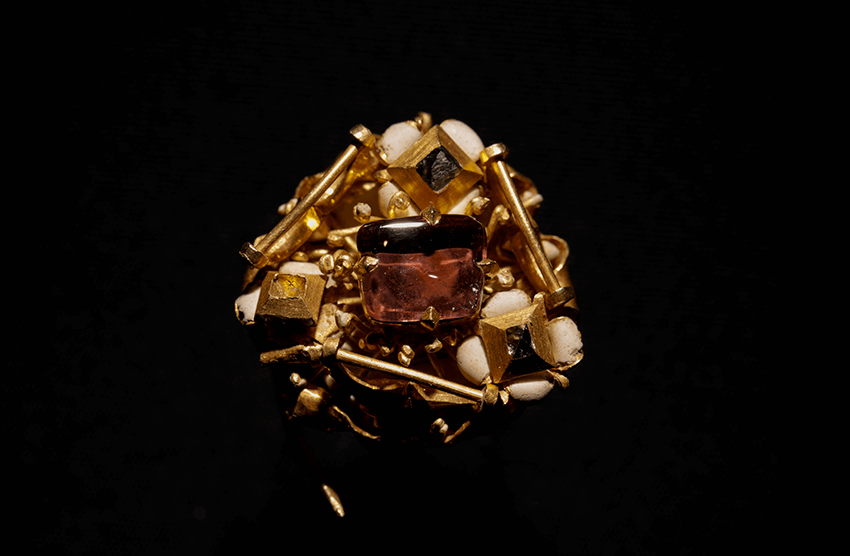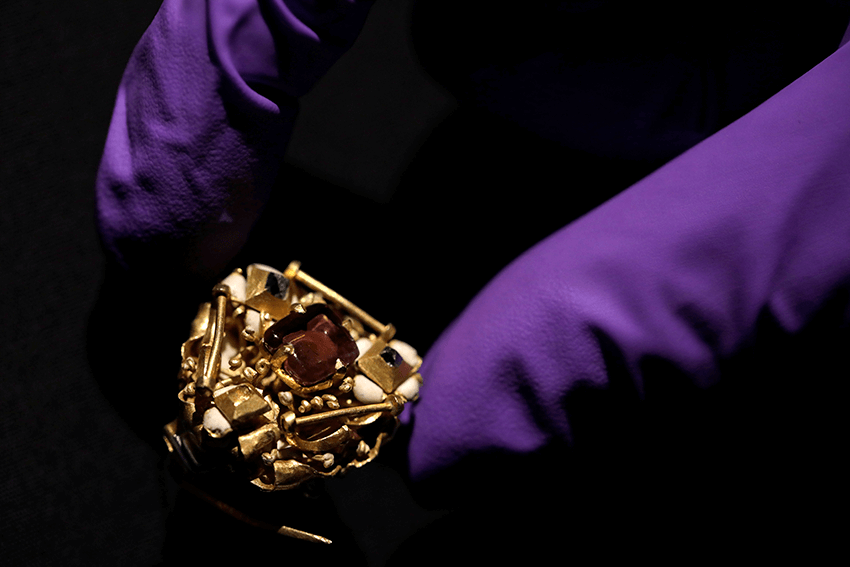Real-life Buried Treasure Acquired by V&A Museum
V&A Museum Acquires Rare Jewelled Medieval Brooch
Reading Time:
1 min {{readingTime}} mins
Found on former Royal hunting grounds, this unique Medieval Brooch was a rare find for metal detectorist Justin Owens. After being mistaken for a dirty bottle cap, it's now proudly on display within the V&A's incredible jewellery collections. If jewellery could talk, we wonder what stories it could tell...
The V&A Museum has acquired a rare jewelled late Medieval cluster brooch after it was uncovered in 2017 by a metal detectorist in the former Royal Hunting Ground known as 'Great Park' near Brigstock, Northamptonshire. Dating fromc. 1400-1450, the brooch hails from either France or Germany. It's one of only seven known examples in the world and the only one of its kind to be found in the UK.
Since arriving at the V&A, the brooch has undergone painstaking cleaning and conservation by Senior Metalwork Conservator, Joanna Whalley. Whalley used intricate tools, including pheasant and ostrich feathers, to limit damage as she removed layers of dirt to get it ready for public display. Conservation treatment acted as micro-archaeology as nearly 600-years of mud was meticulously dislodged to reveal the intricate 3D structure of the brooch.

Justin Owens, metal detectorist, said:
“Finding the brooch was a complete surprise – I couldn’t believe it. At best I’d hope to come across a Roman or Medieval hammered coin on a dig, but to find something so rare and valuable as this was a total shock. When I first found it, it was absolutely caked in mud. I didn’t have high hopes, thinking it might be an old bottle top or something. But what a discovery! Now I’ve seen it cleaned up by the V&A’s conservators, I can’t believe how exquisite it really is. The gold work is incredible, and the jewels are stunning. It’s amazing to think who might have worn this and how it ended up buried underground, undisturbed, for so many years. I’m excited it’s now in the V&A’s collection and on display in its jewellery gallery for everyone to enjoy. I’m looking forward to visiting myself very soon.”
The second acquisition the V&A has ever made through the National Treasure Act, which legally obliges finders of objects which constitute treasure (as defined in the Act) to report their find to their local coroner within 14 days. where they determine whether the find constitutes treasure or not. If it is, then the finder must offer the item for sale to a museum at a price set by an independent board of antiquities experts known as the Treasure Valuation Committee (Only if a museum expresses no interest in the item, or is unable to purchase it, can the finder retain it).
The sculptural brooch measures 23.63mm x 22.71mm x 16.81mm in size and weighs 16.60 grams. It will go on display in the V&A’s William and Judith Bollinger Jewellery Gallery as part of a display on Medieval jewellery from Thursday 12 March. The brooch was also featured in the final episode of BBC Two’s Secrets of the Museum.

Triangular in shape, the gold brooch in the form of a flower is mounted with two diamonds and one central cabochon spinel, with enamel decoration, and pearls, which have since been lost due to degradation. The brooch lay hidden just four inches below ground for nearly 600 years before it was dug up on 10 June 2017 by metal detectorist, Justin Owens, using his Minelab E-TRAC metal detector.
The brooch is full of religious and romantic symbolism. During the period, diamonds were associated with strength and eternity due to the belief that they could not be broken or destroyed, while red stones such as spinels symbolised passion as well as good health, and pearls represented purity. Such brooches were made for an affluent and courtly clientele. Worn on the shoulder or breast, together with sumptuous textiles and other pieces of jewellery, they played an important part for the display of status and wealth in courtly fashion.
The loss of some diamonds and the brooch’s severely bent pin reveal the visible trauma it would have suffered when it was likely wrenched off its aristocratic wearer at great force and lost during the chase as part of a hunt. The very fact it was lost, buried and preserved in the ground for so many years is the reason it survives today. If not, it would have almost certainly have been melted down and repurposed

James Robinson, Keeper of Sculpture, Metalwork, Ceramics and Glass at the V&A, said:
“Jewellery often has an inventiveness, an emotional character and a longevity that transcends the death of its original wearer as a gateway to unlock the past. This intriguing and exquisite late Medieval cluster brooch is a rare survivor with a tantalising story to tell. It’s sculptural design, exceptionally fine gold and enamel work, stunning diamonds, central cabochon spinel and pearls (now lost), all express burgeoning opulence and extreme wealth. It would have been made for someone from the highest echelons of society. The loss of some diamonds and the brooch’s severely bent pin belie the visible trauma it would have suffered when it was likely ripped off its wearer during the thrill of a hunt. It makes a truly captivating and unique addition to our world-class jewellery collection, which traces the story of jewellery in Europe from ancient times to the present day.”
The V&A has one of the finest and most comprehensive collections of jewellery in the world - The Benchpeg team had the pleasure of revisiting it last year (we'd definitely recommend a trip!). With over 3,000 jewels tell the story of jewellery in Europe from ancient times to the present day - now, this brooch sits among them.
Author:
Published:









